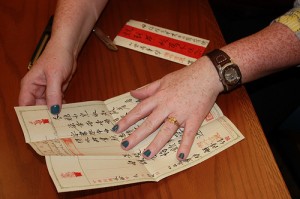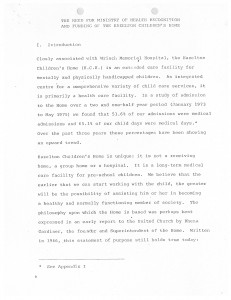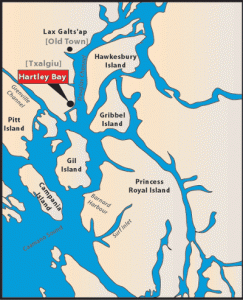May 25th, 2011 by sromkey | No Comments »
We recently had our friends from Chinese Canadian Stories (CCS) join us to host high school students from Sir Winston Churchill Secondary School for a tour of the Chung Collection and a Mandarin language lesson. Afterward, the researchers from CCS mentioned they had found an unopened letter in the Wah Shun Company fonds– could we open it and read what was inside?
Usually when we are first processing a new archival collection we will open unopened envelopes unless there is a compelling reason not to do so (for example a privacy concern, in which case the envelope would not be made available to researchers anyway). The thinking behind this practice is that it would be better for the letter to be gently opened by an archivist than to be torn open by a well-meaning but potentially destructive patron.
Since we had cameras on hand to document the collection tour, the CCS researchers also took photos of the letter opening. We opened it by carefully cutting a very thin slice off the top of the envelope with a pair of scissors. The letter is in Chinese but thankfully Joanne and Lilly from CCS were able to read it for us- the letter was written from a Chinese man in Vancouver, to his son in China, explaining that he was going to be sending him some goods and supplies, and also giving him advice on studying hard in school. No one may ever know why the letter wasn’t sent!

Opening the letter from the Wah Shun Company fonds
The letter can be found in Box 1 folder 3 of the Wah Shun Company fonds.
The photo is courtesy of the Chinese Canadian Stories project.
Posted in Collections, Research and learning | No Comments »
May 17th, 2011 by sromkey | No Comments »
This week our featured place, and Irving K. Barber Learning Centre room name, is Hazelton. Hazelton, as well as New Hazelton and South Hazelton, is located near where the Skeena River meets the Bulkley River, northeast of Prince Rupert. The Hazelton area is the traditional land of the Gitxsan and Wet’suwet’en First Nations.
The featured document is from the Social Planning and Research Council (SPARC) of British Columbia fonds. SPARC is a non-partisan organization that was founded in 1966 to “work with communities in building a just and healthy society for all” (from the SPARC website). The archives here at RBSC include files from 1966 to 1984 and contain a wealth of information on the history of social issues and programs in B.C., from youth, housing, health, aging, and much more. One such file is on the Hazelton Children’s Home. Founded by the United Church in 1967, the Hazelton Children’s Home appears to have run at least into the 1980’s. It is described in the file as “an extended care facility for mentally and physically handicapped children.” The files contain a request for funding written to the Skeena Health Unit in 1978. Information about the home is now scarce- the SPARC files as well as files at the Bob Stewart United Church Archives appear to be two of few sources.

Document from SPARC fonds
A finding aid for the SPARC fonds is available, and if you are new to archival research, we recommend our Archival Materials Research Guide.
In the Barber Centre, the Hazelton Classroom is on the fourth floor in the south end of the building.
Posted in Collections | No Comments »
May 4th, 2011 by sromkey | No Comments »
Always wanted to “go down in the history books” but not sure how? It’s easy- answer the 2011 Canadian census, and answer YES to question 10. The census is a rich source of information for future researchers to understand ordinary Canadians. But they will only be able to see your data if you answer YES to question 10, which allows your data to be made available in 92 years, in the year 2103.

Graphic courtesy of the Association of Canadian Archivists.
The Association of Canadian Archivists is advocating for all Canadians to be aware of the implications behind question 10. Unfortunately, in the 2006 census only 56% of respondents agreed to allow their responses to be released in the year 2098. What can you do to stop this from happening again?
- Fill in the census form (information available on the Stats Can website if you have not received a form at your home: http://census2011.gc.ca/) and answer YES to question 10.
- Encourage your family and friends to do the same.
- Sign up for the Association of Canadian Archivists Facebook event to show your support.
- Print this poster from the ACA and hang it in your workplace.
To discover the rich information held in census data, go the the Library and Archives Canada Census page. The most recent census data available is from 1911.
Posted in Research and learning | No Comments »
May 3rd, 2011 by Katherine Kalsbeek | No Comments »
This week, we are taking a closer look at the community of Hartley Bay — the community that the Hartley Bay Meeting Room (room 266), in the Irving K Barber Learning Centre is named after.

Image Credit: Map of Hartley Bay, from http://www.gitgaat.net/place/enlargemap.htm
Hartley Bay is the home of the Gitga’at First Nation, members of the Tsimshian cultural group. A village of 200, accessible only by air or water, Hartley Bay is located at the mouth of Douglas Channel, about 630 kilometres north of Vancouver and 145 kilometres south of Prince Rupert.
On March 22, 2006, the people of Hartley Bay were the first responders to the passengers aboard the sinking BC Ferries Queen of the North. The community was recognized for their heroic actions by the Governor General on May 3, 2006 and received the Governor General’s Commendation for Outstanding Service.
The XWI7XWA LIBRARY, located at 1985 West Mall has a variety of material on the community of Hartley Bay, including material in their special collections. Contact Ann Doyle, head of XWI7XWA LIBRARY, for more information on accessing material in the special collections.
Posted in Uncategorized | No Comments »




